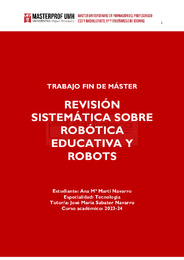Please use this identifier to cite or link to this item:
https://hdl.handle.net/11000/33188Full metadata record
| DC Field | Value | Language |
|---|---|---|
| dc.contributor.advisor | Sabater-Navarro, Jose Maria | - |
| dc.contributor.author | Martí Navarro, Ana María | - |
| dc.date.accessioned | 2024-09-17T12:38:54Z | - |
| dc.date.available | 2024-09-17T12:38:54Z | - |
| dc.date.created | 2024-06 | - |
| dc.identifier.uri | https://hdl.handle.net/11000/33188 | - |
| dc.description | Especialidad: Tecnología | es_ES |
| dc.description.abstract | Este estudio examina sistemáticamente la robótica y los robots educativos (ERR por su siglas en inglés) con dos propósitos. (1) Clasificar la investigación sobre la ERR para identificar las tendencias y las brechas de la investigación, (2) Resumir los hallazgos experimentales relacionados con la ERR e interpretarlos de acuerdo con las afirmaciones de la literatura. En este estudio se ha empleado un método mixto que combina el mapeo sistemático y la revisión sistemática. Se han analizado mediante un proceso de mapeo sistemático noventa y tres artículos publicados en revistas indexadas en el Social Sciences Citation Index (SSCI) y que cumplieron con los criterios especificados. Los resultados mostraron que 40 de los 93 artículos no incluían ninguna teoría del aprendizaje. Treinta y dos estudios experimentales fueron analizados en el ámbito de la revisión sistemática. Se resumen los hallazgos empíricos que respaldan algunas de las afirmaciones sobre la ERR y se revelan las lagunas de investigación en las afirmaciones que deben ser respaldadas por enfoques teóricos y pedagógicos | es_ES |
| dc.description.abstract | This study, which systematically examines educational robotics and robots (ERR), has two purposes. (1) Classifying the research on the ERR to identify research trends and gaps, (2) Summarizing the experimental findings related to ERR and to interpret them according to the claims in the literature. A mixed method combining systematic mapping and systematic review were used in the study. Ninety- three articles published in Social Sciences Citation Index (SSCI) indexed journals and meeting the specified criteria were analyzed using a systematic mapping process. The results showed that 40 out of 93 articles did not include any learning theory. Thirty-two experimental studies were analyzed within the scope of the systematic review. The empirical findings supporting some of the claims about ERR are summarized and the research gaps in the claims that need to be supported by theoretical and pedagogical approaches are revealed | es_ES |
| dc.format | application/pdf | es_ES |
| dc.format.extent | 41 | es_ES |
| dc.language.iso | spa | es_ES |
| dc.publisher | Universidad Miguel Hernández | es_ES |
| dc.rights | info:eu-repo/semantics/openAccess | es_ES |
| dc.rights | Attribution-NonCommercial-NoDerivatives 4.0 Internacional | * |
| dc.rights.uri | http://creativecommons.org/licenses/by-nc-nd/4.0/ | * |
| dc.subject | Robótica educativa | es_ES |
| dc.subject | Robots educativos | es_ES |
| dc.subject | Mapeo sistemático | es_ES |
| dc.subject | Revisión sistemática | es_ES |
| dc.subject.other | CDU::3 - Ciencias sociales::37 - Educación. Enseñanza. Formación. Tiempo libre | es_ES |
| dc.title | Revisión sistemática sobre robótica educativa y robots | es_ES |
| dc.type | info:eu-repo/semantics/masterThesis | es_ES |

View/Open:
TFM Martí Navarro, Ana María.pdf
3,56 MB
Adobe PDF
Share:
.png)
